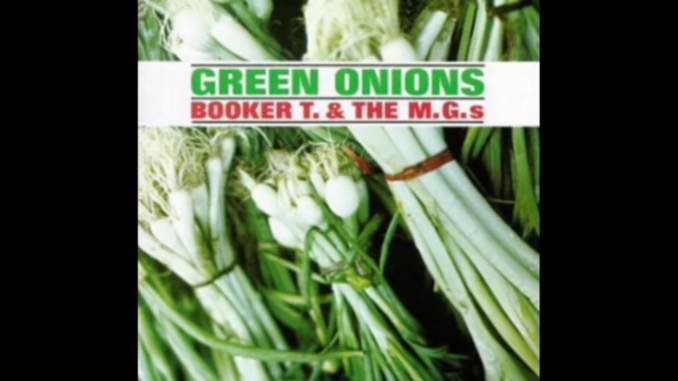
In the late 1950s, several small record labels started a movement in popular music that helped define the 1960s. The sound was known by a number of names, including blues, soul, R&B, funk, Southern soul, and Memphis soul. Motown Records became the most famous, but other labels such as Chess and Stax were equally well known to fans. A sign outside of Motown’s studio read, “Hitsville, USA”. As if the competition between studios needed to be highlighted, the marquee outside of the Stax studio countered with, “Soulsville, USA”.
Stax, located in Memphis, Tennessee, had its own unique sound due to the core group of studio musicians that backed all artists who recorded there. The loose-knit group, numbering between one and two dozen members, occasionally played at public venues and recorded their own tracks. At such times the group was known as the Mar-Keys, a play on the word marquee and a reference to the sign in front of the Stax studio building which had formerly been a movie theater. The Mar-Keys were known as the Stax house band. Normally studio musicians worked five days a week, Monday through Friday, although many also regularly played gigs at local nightspots to survive economically.
Jim Stewart, who owned Stax and engineered and produced most recordings, asked four of the Mar-Keys to work on a Sunday in early 1962. Billy Lee Riley, a rockabilly star of some notoriety, had scheduled studio time and needed just four backup musicians.
Steve Cropper, 20 years old, played electric guitar. He was using a Fender Telecaster that day. Lewie Steinberg, 28, played bass guitar. Al Jackson Jr., 26, was a highly regarded drummer. Booker T. Jones played the Hammond M3 organ. He’d been a child prodigy who also played the oboe, saxophone, trombone, guitar, bass, and piano. Jones was just 17 years old. All four were top-notch talent.
Billy Lee Riley was late. To kill time and warm up for the session, the foursome jammed and played around with a few riffs. Since the recording equipment was already set to record the tardy Riley, Stewart recorded the jam session and was excited by what he heard. Riley still had not shown up (and never did), so Stewart told the four musicians he wanted to make a single out of what he’d just recorded. He just needed a name for the song, a name for the ‘band’, and another tune for side B of the single.
The name of the A-side song became “Behave Yourself”, but the four new band members had no idea what to do for the B-side. Cropper remembered a piano groove that he’d heard Jones play a couple of weeks earlier and suggested they do something around that. Since Jones had played the Hammond M3 for the A-side tune, he thought it only made sense to continue with the organ for the B-side, even though he’d created the groove for piano.
The four, with input from Stewart, put their heads together and worked out parts for the guitars and drums. The result was phenomenal. Jones suggested calling the tune “Onions” because it was stinkin’ (was that a compliment or an insult at the time?), but Cropper thought that sounded too negative. Steinberg suggested “Funky Onions”, but that too was rejected. Someone mentioned that green onions were popular to eat with dinner, and the name stuck. Now they just needed a name for the band.
“Booker T. & The MG’s – Green Onions (Official Audio)” (2:53):
“Booker T. & The M.G.s” had a catchy ring to it. For many years afterwards, the record label insisted M.G. stood for “Memphis Group”. Band members admitted much later they named themselves after the British sports car and that Stax invented Memphis Group to avoid legal trouble.
Volt was a subsidiary of Stax, a common practice in the industry made neccessary by radio stations refusing to play too many hit records from a single label. It was an effort to avoid any perception of favoritism, as the sting of the payola scandal was still fresh in the minds of many in the music biz. “Green Onions” was issued on the Volt label as the B-side of the 45rpm single in May 1962. This was the second record ever released by Volt; as such it is known as Volt 102.
Stax had a distribution agreement with Atlantic. When the music executives at Atlantic heard “Green Onions”, they insisted on re-issuing it as the A-side on the Stax label. That release took place in August 1962 (Stax 127). The album “Green Onions” was also released in ’62.
The single version of “Green Onions” made the US Billboard Hot 100 list in the week ending on August 11. It peaked on the Hot 100 in the number 3 spot for the week ending on September 29. “Green Onions” reached number 1 on the US Billboard Hot R&B Sides chart.
“Green Onions”, made in a single day on a whim, has been greatly influential. The iconic tune has been a feature on many memorable movie soundtracks and has been honored in the following ways:
- Rolling Stone ranked it #181 out of 500 greatest songs of all time (and the only instrumental that made the list)
- Acclaimed Music ranks it as the 137th greatest track of all time, and the best track of 1962
- Grammy Hall of Fame Award, 1999
- Colin Larkin’s Top 1000 Albums voted it number 5 in the All-Time Top 100 Singles.
In a 2008 interview, Steve Cropper told the story of how “Green Onions” was created. (8:28):
Question of the Night: Name your favorite musician/group, song, and genre from the 1960s.
